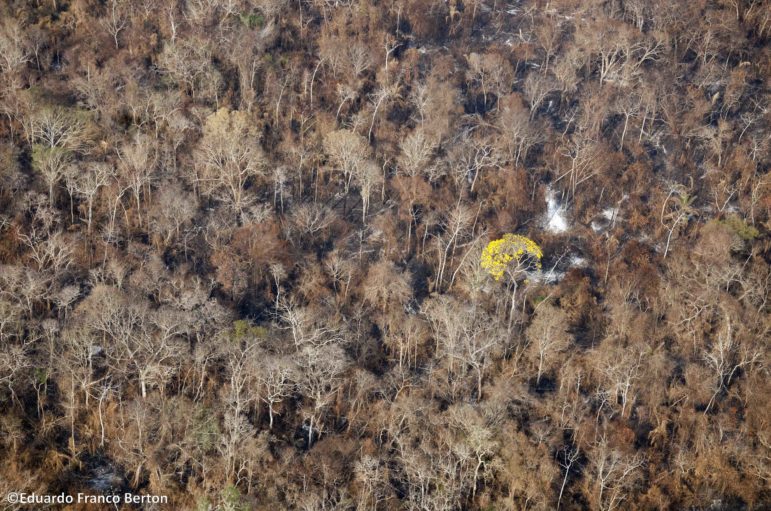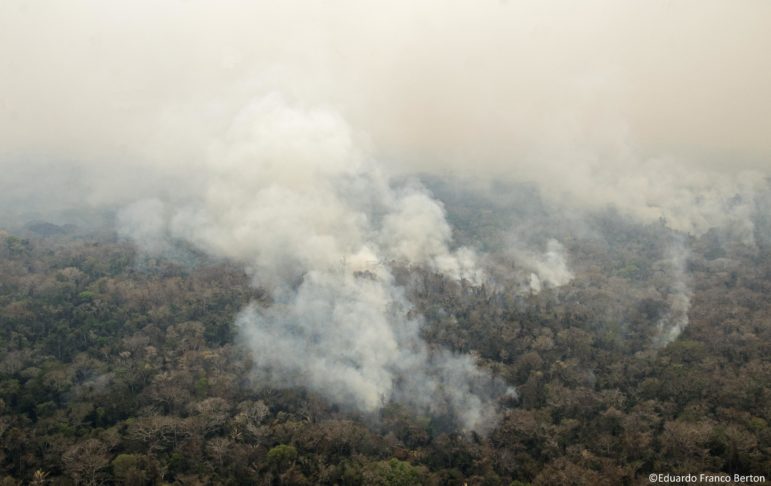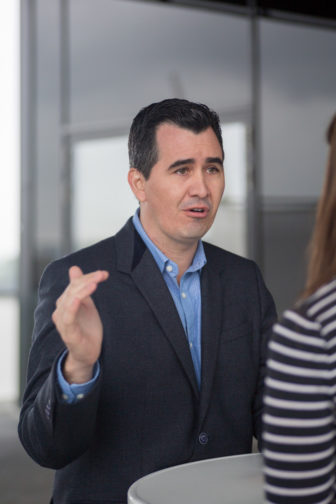
Franco Breton’s image of a lone tree flowering amid the devastation went viral in Bolivia. Photo: Eduardo Franco Berton
When the Chiquitano dry forest began to burn this summer, environmental photographer Eduardo Franco Berton thought it was just another dry season in Bolivia. For years, as more people migrated to the region from other parts of the country to farm, fires would break out at this time of year. But it soon became clear that this year was different.
The region is a transition zone for the Amazon rainforest, which also experienced the worst fire season in more than a decade this summer. And as Brazilian president Jair Bolsonaro traded barbs with G-7 leaders over how to fight the blaze, Bolivian citizens began to demand that President Evo Morales, who is facing an election next month, do more to take on the slash-and-burn farming practices that caused the fires.
Franco Berton and his colleagues, documentary filmmaker Ernst Drawert and pilot Mario Loayza, wanted to see the damage for themselves. “We decided we needed to show the magnitude of this,” Franco Berton said.
They chartered a small plane and flew out over the forest to capture the extent of the devastation. It was enormous. Two weeks later, 4.1 million hectares – an area 55 times the size of Hamburg, where Franco Berton shared their findings at the 11th Global Investigative Journalism Conference, had burned in Bolivia alone.
The team took their first flight across the worst-affected area before being asked to clear the way for a Supertanker firefighting plane, on loan from the US. When the Supertanker was finished, they flew back over. Much of the forest was still ablaze.
“When you see a 15- to 20-kilometer fire, and you have the Supertanker reaching up to 5 or 7 kilometers, it’s like fighting Goliath,” he said. “It was uncontainable, just out of control.”
They tried to avoid flying through the thick smoke billowing out of the forest, but that wasn’t always possible. “In some parts it was coming towards us, and when it does you can’t actually breathe,” he said.
One of the photographs Franco Berton came back with – a lone flowering tree standing in a completely obliterated swath of forest – went viral, alerting people across the country and around the world to the extent of the damage.
“Influencers and well-known journalists began to use it as their profile pictures; people were sharing the story on Facebook. And now it’s being used by a huge corporation [Farmacorp] to raise money to fight the fires,” he said.

An area of 4.1 million hectares had burned in Bolivia within weeks. Photo: Eduardo Franco Berton
Franco Berton started out as a wildlife photographer, hiding out on the forest floor for hours to capture a passing jaguar. But as the effects of the climate crisis began to show in this unique ecosystem, he realized he needed to take to the air.
He had previously used drones to capture deforestation, but fires this large required access by plane. “Drones are good, but when you have a case like this, some of the places you have to get to are too far away,” he said. Using a drone can get you footage of 500 meters, perhaps a kilometer. These fires were burning across 20 times that distance.
The team used satellite data provided by Global Forest Watch and Bolivian site SATRIFO to plot their route across the forest, capturing the damage as they went.
Franco Berton is a freelancer, funded largely by grants. Flying a private plane is not cheap, and there’s no grant available quickly enough to send you into the path of a fire that has just begun to burn. He was lucky, he said, that the owner of the plane was a committed conservationist, and could give the team a reduced rate for the flights. Even so, getting the money together was a scramble. They had to assemble funds from other projects to raise the cash to make the flight.
“We said, ‘We have to do this – we cannot just sit here and record from the ground, we need to so something more,’” he said. “So we took some risky financial decisions.”
Franco Breton added that he’s operating out of a sense of great urgency, as his country nears the point of no return when it comes to climate change.

“There is a sense of urgency that we as journalists have to absorb and explain to readers,” Franco Berton said. Photo: Nina Weymann-Schulz
Not only are global temperature rises affecting the region, but rapid deforestation is causing the local microclimate to change. When forests are burned, rains are delayed, and water supply for millions is put at risk. In 2018, Bolivia was fifth on the list of countries losing the largest swathes of primary tropical rainforest.
When the tipping point is reached, he said, “even the areas that haven’t been touched will get affected, like a cancer. The forest will start dying.”
Franco Berton believes journalists have as much responsibility as scientists to stop that from happening. “There is a sense of urgency that we as journalists have to absorb and explain to readers,” he said.
His photograph being used by Farmacorp to raise money to fight the fires is one example. “Besides the journalism, we can contribute more,” he said. “With photography, you can do much more than you plan.”

Megan Clement is a journalist and editor specializing in gender, human rights, international development and social policy. She also writes about Paris, where she has lived since 2015.
